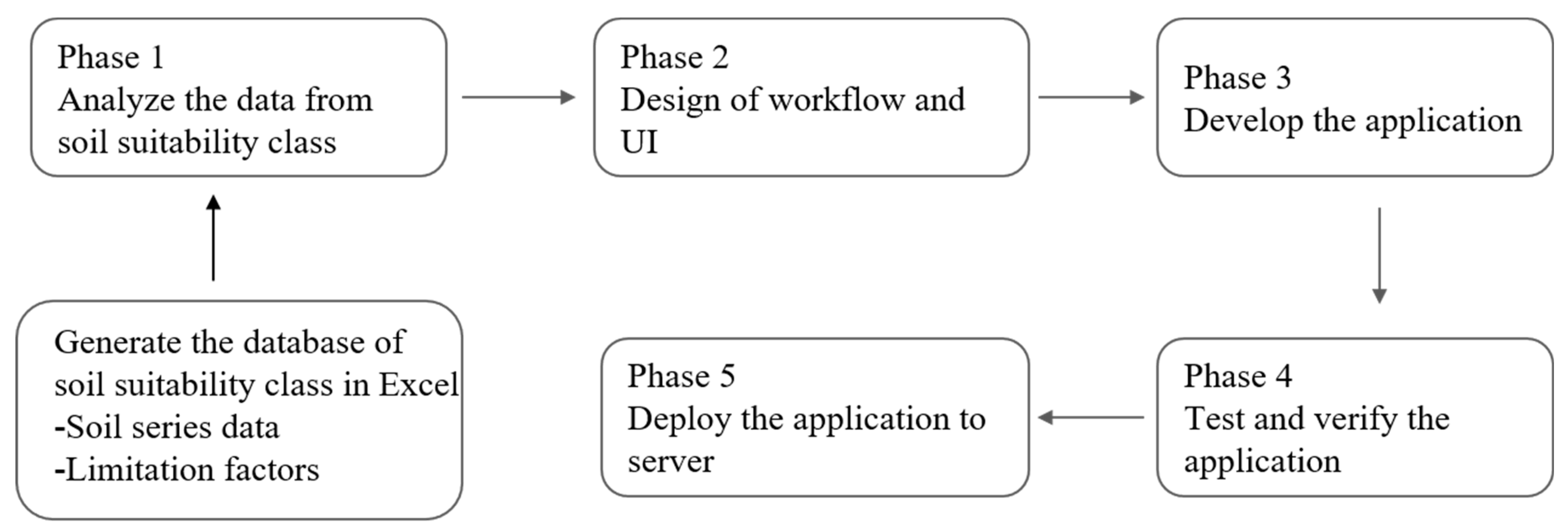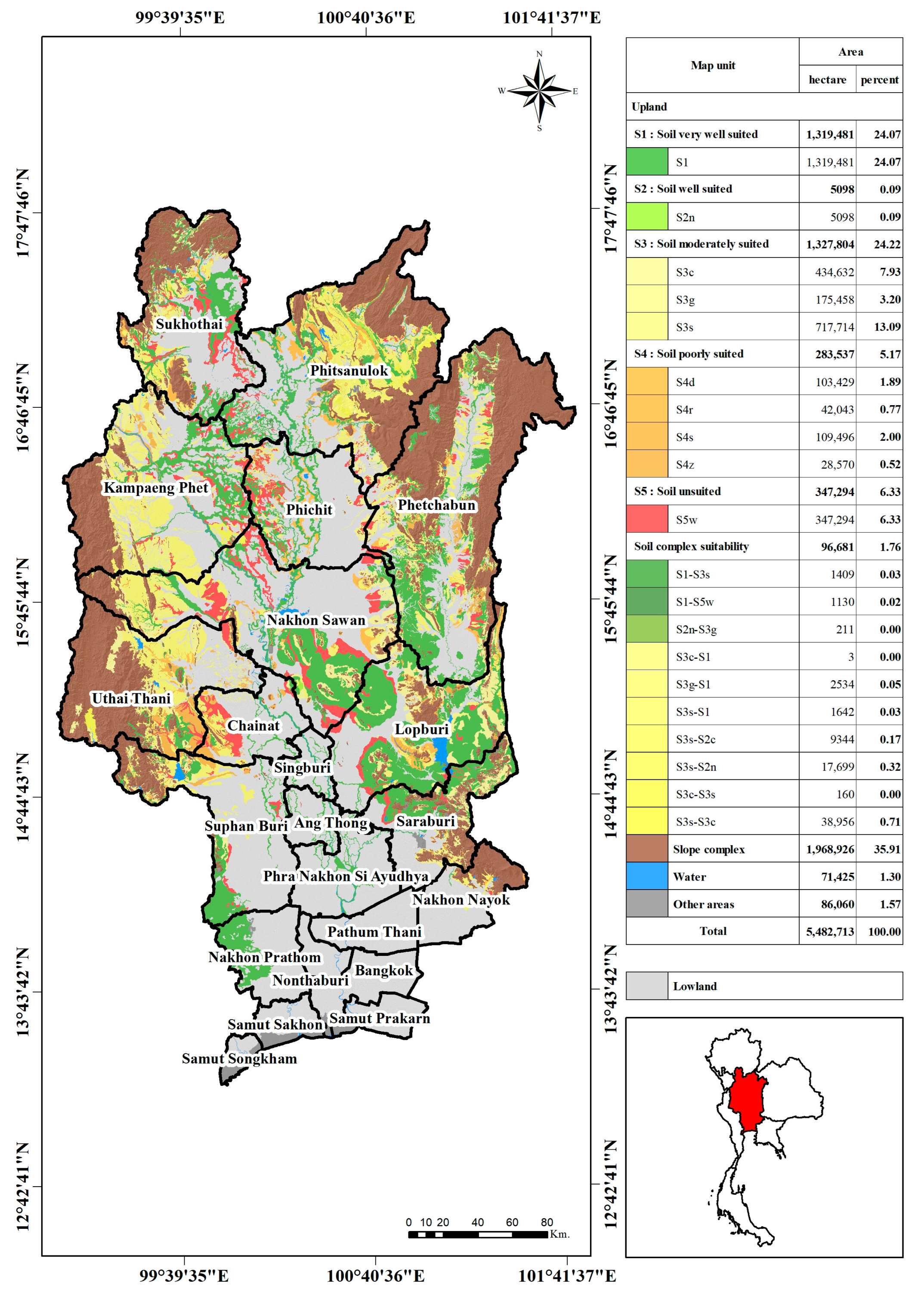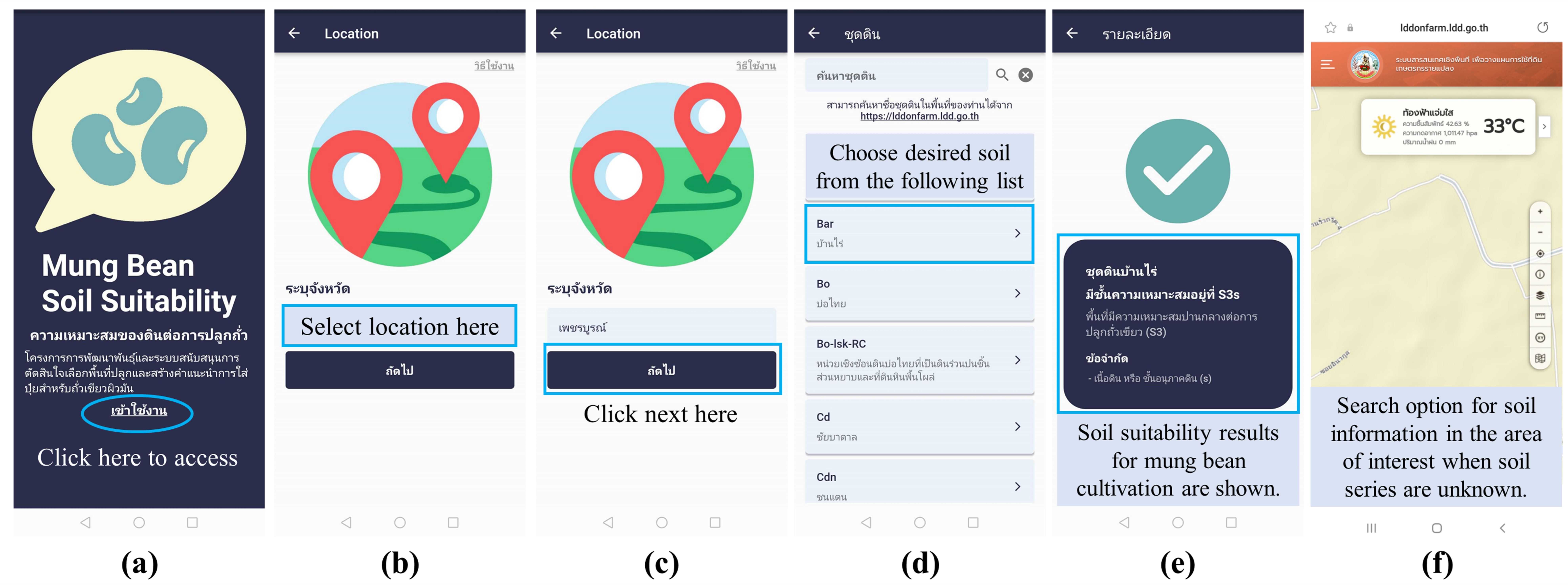Decision Support System for Selecting Mung Bean Cultivation Sites in Central Thailand Based on Soil Suitability Class
Abstract
1. Introduction
2. Materials and Methods
3. Results
3.1. Mung Bean Planting Areas
3.2. Soil Suitability Assessment for Mung Bean Cultivation
3.3. Decision Support System for Mung Bean Plantation as a Mobile Application
3.4. Agronomic and Yield-Related Traits, and Yield of Mung Beans in the Cultivated Areas with Different Soil Suitability Classes
4. Discussion
5. Conclusions
Supplementary Materials
Author Contributions
Funding
Data Availability Statement
Acknowledgments
Conflicts of Interest
References
- de Jager, I.; Borgonjen-van den Berg, K.J.; Giller, K.E.; Brouwer, I.D. Current and potential role of grain legumes on protein and micronutrient adequacy of the diet of rural Ghanaian infants and young children: Using linear programming. Nutr. J. 2019, 18, 12. [Google Scholar] [CrossRef] [PubMed]
- Sequeros, T.; Ochieng, J.; Schreinemachers, P.; Binagwa, P.H.; Huelgas, Z.M.; Hapsari, R.T.; Juma, M.O.; Kangile, J.R.; Karimi, R.; Khaririyatun, N.; et al. Mungbean in Southeast Asia and East Africa: Varieties, practices and constraints. Agric. Food Secur. 2021, 10, 1–13. [Google Scholar] [CrossRef]
- Vangnai, S. Current situation of nodulated legumes in Thailand. J. Sci. Soc. Thailand 1981, 7, 18–24. [Google Scholar] [CrossRef]
- Sutjaritjai, N.; Wangpakapattanawong, P.; Balslev, H.; Inta, A. Traditional uses of Leguminosae among the Karen in Thailand. Plants 2019, 8, 600. [Google Scholar] [CrossRef]
- Corn, Soybeans, Mung Beans and Peanuts: Direction of Thai Economic Crops in ASEAN. Available online: https://www.arda.or.th/ebook/file/5Policy4.pdf (accessed on 2 March 2022).
- Aung, P.P.P.; Lee, J.Y. Technical efficiency of mung bean producers: The case of Myanmar. Agriculture 2021, 11, 1249. [Google Scholar] [CrossRef]
- Wang, L.; Wang, S.; Luo, G.; Zhang, J.; Chen, Y.; Chen, H.; Cheng, X. Evaluation of the production potential of mung bean cultivar “Zhonglv 5”. Agronomy 2022, 12, 707. [Google Scholar] [CrossRef]
- Favero, V.O.; Carvalho, R.H.; Motta, V.M.; Leite, A.B.C.; Coelho, M.R.R.; Xavier, G.R.; Rumjanek, N.G.; Urquiaga, S. Bradyrhizobium as the only rhizobial inhabitant of mung bean (Vigna radiata) nodules in tropical soils: A strategy based on microbiome for improving biological nitrogen fixation using bio-products. Front. Plant Sci. 2021, 11, 602645. [Google Scholar] [CrossRef]
- Ali, M.; Gupta, S. Carrying capacity of Indian agriculture: Pulse crops. Curr. Sci. 2012, 102, 874–881. [Google Scholar]
- Thailand Foreign Agricultural Trade Statistics. Available online: http://dataset.nabc.go.th/dataset/6196e084-2e4e-4bc7-888c-49336aaf3c7e/resource/62220b44-c151-4f25-976e-e07657de9dc7/download/31-02-63.pdf (accessed on 25 March 2022).
- Nadeem, F.; Nawaz, A.; Farooq, M. Crop Rotations, Fallowing, and Associated Environmental Benefits. In Oxford Research Encyclopedia of Environmental Science; Oxford University Press: Oxford, UK, 2019. [Google Scholar]
- Peiris, H.; Kaveeta, R.; Rangsipaht, S.; Pitakdantham, R. Effects of Thailand and Sri Lanka agronomic practices on Mungbean (Vigna radiata (L.) Wilczek) production in rice-based cropping system. Agric. Nat. Resour. 2016, 50, 286–290. [Google Scholar] [CrossRef]
- Kumar, P.; Pal, M.; Joshi, R.; Sairam, R.K. Yield, growth and physiological responses of mung bean [Vigna radiata (L.) Wilczek] genotypes to waterlogging at vegetative stage. Physiol. Mol. Biol. Plants 2013, 19, 209–220. [Google Scholar] [CrossRef]
- Singh, D.P.; Singh, B.B. Breeding for tolerance to abiotic stresses in mungbean. J. Food Legum. 2011, 24, 83–90. [Google Scholar]
- Ahmed, S.; Higuchi, H.; Nawata, E.; Sakuratani, T. Effects of exogenous ABA and ethylene application and waterlogging on photosynthesis in mungbean (Vigna radiata (L.) Wilczak). Jpn. J. Trop. Agric. 2002, 46, 166–174. [Google Scholar]
- Ahmed, S.; Nawata, E.; Sakuratani, T. Changes of endogenous ABA and ACC, and their correlations to photosynthesis and water relations in mungbean (Vigna radiata (L.) Wilczak cv. KPS1) during waterlogging. Environ. Exp. Bot. 2006, 57, 278–284. [Google Scholar] [CrossRef]
- FAO. A Framework for Land Evaluation. In Soil Resources, Development and Conservation Service, Land and Water Development Division; Food and Agriculture Organization of the United Nations: Rome, Italy, 1976. [Google Scholar]
- Forkuor, G.; Hounkpatin, O.K.; Welp, G.; Thiel, M. High resolution mapping of soil properties using remote sensing variables in south-western Burkina Faso: A comparison of machine learning and multiple linear regression models. PLoS ONE 2017, 12, e0170478. [Google Scholar] [CrossRef] [PubMed]
- Kalambukattu, J.G.; Kumar, S.; Arya Raj, R. Digital soil mapping in a Himalayan watershed using remote sensing and terrain parameters employing artificial neural network model. Environ. Earth Sci. 2018, 77, 1–14. [Google Scholar] [CrossRef]
- Che’Ya, N.N.; Mohidem, N.A.; Roslin, N.A.; Saberioon, M.; Tarmidi, M.Z.; Arif Shah, J.; Fazlil Ilahi, W.F.; Man, N. Mobile computing for pest and disease management using spectral signature analysis: A review. Agronomy 2022, 12, 967. [Google Scholar] [CrossRef]
- Soil Data Service and Use. Available online: http://dinonline.ldd.go.th/Login.aspx?service=4 (accessed on 25 March 2022).
- Somta, P.; Ngampongsai, S.; Masari, A.; Phoomthaisong, J.; Phruetthithep, C.; Bunsak, C.; Punlai, N.; Suwanprasert, J.; Thiempeng, P.; Budthong, T. Advanced Yield Trial of New Mungbean Breeding Lines of Thailand: Final Report; National Science and Technology Development Agency: Nakhon Pathom, Thailand, 2017. [Google Scholar]
- Sirappa, M.P.; Waas, E.D.; Susanto, A.N. Land suitability and purposed land use of Selaru Island, West-Southeast Moluccas regency. J. Trop. Soils 2018, 15, 169–178. [Google Scholar] [CrossRef]
- Phankamolsil, N.; Sonsri, K.; Kheoruenromne, I.; Gilkes, R.J.; Phankamolsil, Y. Spatial distribution characteristics and types of salt-affected soils spots developed on alluvial fan complex over old marine sediment, Thailand. Agric. Nat. Resour. 2021, 55, 229–236. [Google Scholar]
- Ayenew, W.A.; Ayene, H.; Wubalem, K. Land suitability analysis for mung bean production using a GIS based multi-criteria technique in part of Wollo, Amhara region, Ethiopia. J. Econ. Sustain. Dev. 2020, 11, 29–36. [Google Scholar]
- Srisomkiew, S.; Kawahigashi, M.; Limtong, P. Digital mapping of soil chemical properties with limited data in the Thung Kula Ronghai region, Thailand. Geoderma 2021, 389, 114942. [Google Scholar] [CrossRef]
- Rahim, S.E.; Supli, A.A.; Damiri, N. Developing a land suitability evaluation tool in mobile android application for rubber, cocoa and oil palm. J. Int. Soc. Southeast Asian Agric. Sci. 2016, 22, 80–90. [Google Scholar]
- Siddiqua, A.; Kabir, M.A.; Ferdous, T.; Ali, I.B.; Weston, L.A. Evaluating plant disease detection mobile applications: Quality and limitations. Agronomy 2022, 12, 1869. [Google Scholar] [CrossRef]
- Petrellis, N.; Antonopoulos, C.; Keramidas, G.; Voros, N. Mobile plant disease classifier, trained with a small number of images by the end user. Agronomy 2022, 12, 1732. [Google Scholar] [CrossRef]
- Mackie-Dawson, L.A. The effect of surface soil consolidation on the early root development of pea (Pisum sativum L.). Plant Soil 1989, 116, 126–128. [Google Scholar] [CrossRef]
- Chungopast, S.; Thongjoo, C.; Islam, A.M.; Yeasmin, S. Efficiency of phosphate-solubilizing bacteria to address phosphorus fixation in Takhli soil series: A case of sugarcane cultivation, Thailand. Plant Soil 2021, 460, 347–357. [Google Scholar] [CrossRef]
- Suzuki, S.; Noble, A.D.; Ruaysoongnern, S.; Chinabut, N. Improvement in water-holding capacity and structural stability of a sandy soil in Northeast Thailand. Arid. Land Res. Manag. 2007, 21, 37–49. [Google Scholar] [CrossRef]
- Herawati, A.; Syamsiyah, J.; Baldan, S.K.; Arifin, I. Application of soil amendments as a strategy for water holding capacity in sandy soils. IOP Conf. Ser. Earth Environ. Sci. 2021, 724, 012014. [Google Scholar] [CrossRef]



| Type of Limitation | Symbol | Suitability Class | ||||
|---|---|---|---|---|---|---|
| S1 | S2 | S3 | S4 | S5 | ||
| Topography (%) a | t | - | - | 5–12 | >12–20 | >20 |
| Soil texture at 0–25 cm | s | - | - | sl | s, ls | - |
| Consolidation layer >60% (cm) b | c | - | - | >25–50 | 15–25 | <15 |
| Gravel 35–60% (cm) | g | - | - | 25–50 | <25 | - |
| Rockiness (% of areas) | r | - | 0.1–2 | >2–10 | >10–50 | >50 |
| Stoniness (% of areas) | z | - | 0.1–3 | >3–15 | >15–50 | >50 |
| Salinity at 0–25 cm (ds/m) | x | - | - | 2–4 | >4–6 | >6 |
| Drainage | d | - | - | - | spd, sex | ex, pd, vpd |
| Flooding hazard (times/10 years) | f | - | 1–2 | 3–4 | 5–8 | >8 |
| Water logging | w | - | - | - | - | water logging |
| Risk of moisture shortage | m | - | slight | moderate | severe | |
| Nutrient status at 0–25 cm c | n | - | low | - | - | - |
| Acidity (pH) at 0–25 cm | a | - | - | - | <4.5 | - |
| Alkalinity (pH) at 0–25 cm | k | - | - | >8.0 | - | - |
| Acid sulfate layers (cm) | j | - | - | >50–100 | >25–50 | <25 |
| Erosion | e | - | - | me | se | vse |
| Province | Growing Season | Area (ha) |
|---|---|---|
| Uthai Thani | Dry season (after rice crop) and rainy season | 6400–8000 |
| Phetchabun | Dry season (after rice crop) and rainy season | 4800–6400 |
| Nakhon Sawan | Dry season (after rice crop) and rainy season | 3200–6400 |
| Lopburi | Dry season (after rice crop) and rainy season | 3200–6400 |
| Saraburi | Dry season (after rice crop) and rainy season | 1600–3200 |
| Kamphaeng Phet | Dry season (after rice crop) | 3200–6400 |
| Phichit | Dry season (after rice crop) | 3200–6400 |
| Phitsanulok | Dry season (after rice crop) | 3200–6400 |
| Chainat | Dry season (after rice crop) | 1600–3200 |
| Suphan Buri | Dry season (after rice crop) | 1600–3200 |
| Sing Buri | Dry season (after rice crop) | <1600 |
| Soil Suitability Class | Soil Mapping Unit a | Area (ha) |
|---|---|---|
| Soil very well suited (S1) | Bg, Bg-hb, Cd, Cd-Ln, Cg, Chp, Chp-fsi, Ci, Cm-fsi, Ct, Ct-lb, Dl, Dl-md, Dl-RL, Don, Don-f, Don-fl, Don-md,f, Hs-md, Kld, Kmr-fsi, Kp, Kp-fl, Kp-Kp-fl, Ks, Lao, Lb, Lb-br, Lb-md, Lg, Ln, Ln-Sat, Ls, Mi, Mt, Mt-md, Nal, Nal-md, Nm, Pa, Pc, Pc-hb, Pc-md, Pch, Png-fsi, Png-vd, Png-vd,fsi, Pr, Pur, Pur-f, Pur-md,f, Sat, Sg-fl, Sn, Sn-lb, Sn-lb,md, Tk-d, Tk-md, Tph, Tw, Wc, Wi, Wi-fl, Wi-fsi, Wi-md, Wi-md,fl, Wi-md,fsi, Wi-md,fsi-Wi-fsi, Ws, Ws-d, Ws-vd, Ws-Wi | 1,319,841 |
| Soil well suited (S2) | AC-mw,fl, Cg-mw,br, Khu-md, Pur-mw,br, Pur-mw,f,br, Pur-Pur-md, Sn-Ct, Sn-lb,d,mw, Wi-lb | 5098 |
| Soil moderately suited (S3) | AC-mw,col, AC-wd,col, Bar, Bar-fl, Cdn, Cdn-fl, Ch, Ckr, Ckr-fl, Ckr-hb, Cpg, Cpg-fl, Dc, Dc-fl, Dr, Dr-col, Dr-hb, Ds, Ds-col, Ds-col-Ds-md,col, Ds-Ds-md, Ds-md, Hc, Hc-md, Hs, Kak, Kak-lsk, Kb, Khu, Khu-col, Khu-fsi, Khu-lsk, Kok, Kpg-fl, Kpg-hb, Kpg-hb,fl, Ksp, Li, Lsk, Lsk-fl, Ly, Ly-d, Ly-Ty, Ly-Ty-hb, Ly-vd, Ml, Ml-cal, Mm, Mm-d,fsi, Mm-fsi, Mr, Mt-fl, Ncu-lsk, Nd, No, Ns, Ns-md, Pae, Pch-fl, Pch-hb, Pch-hb,fl, Pch-hb,md, Pch-hb,md,fl, Pch-md, Pch-md,fl, Pe, Pe-col, Pe-vd, Phi, Phi-d, Phi-d,fl, Phi-fl, Phi-md, Phi-md,col, Phi-md,fl, Phi-vd,fl, Png, Png-d,col, Png-lsk, Po, Ps, Ptc, Ptc-d, Ptc-fl, Ptc-fl-Ptc-md,fl, Ptc-hb,md,fl, Ptc-hb,mw,fl,br, Ptc-md, Ptc-md,fl, Ptc-mw,br, Ptc-mw,fl,br, Ptc-Ptc-md, Ptc-Ptc-md,fl, Pu, Pu-d,fl, Pu-fl, Pu-fl-Pu-md,fl, Pu-hb,mw,br, Pu-lsk, Pu-md, Pu-md,br, Pu-md,fl, Pu-md,fl,br, Pu-mw,br, Pu-mw,d, Pu-mw,fl,br, Pu-Pu-lsk, Pu-Pu-md, Pur-lsk, Sg, Sg-Kp-fl, So, Sp, Sp-fl, Sp-hb, Sp-hb,fl, Sp-hb,lsk, Sp-lsk, Suk, Suk-hb, Suk-pic, Tas, Tk, Tk-br, Tm, Ty, Ty-hb, Uti, Uti-fl, Uti-hb, Uti-hb,fl | 1,327,804 |
| Soil poorly suited (S4) | Bo, Bo-lsk-RC, Cg-gm, Cm, Cu, Don-md,f-RL, Hc-gm, Hs-md-RL, Hs-RL, Kak-RC, Kld-gm, Kpg, Kpg-tks, Kpg-vtks, Ksp-gm, Ksp-gm,fl, Ml-cal-RC, Ml-RC, Pch-gm, Pch-gm,fl, Pch-gm,pic, Pch-hb,gm, Pch-hb,gm,fl, Pe-gm, Phi-d,gm,fl, Phi-fl-RL, Phi-md,gm,col, Phi-RL, Png-lsk-RC, Ptc-hb,md,f-RC, Pu-d-RC, Pu-gm, Pu-gm,fl, Pu-hb,gm, Pu-hb,gm,fl, Pu-md,fl-RC, Pur-gm, Sg-tks, Sg-vtks, Sn-lb,gm, So-RL, Sp-gm, Sp-gm,fl, Sp-gm,lsk, Sp-hb,gm,fl, Sp-tks, Tas-RC, Tph-gm, Tph-gm,f, Tph-gm,fl, Ty-hb-RC, Ty-RC, Ty-RL, Uti-gm, Uti-gm,fl, Uti-hb,gm, Uti-tks, Uti-vtks, Wi-gm, Wi-gm,fsi, Wk-RC, Ws-gm, Ws-RC, Ws-vd,gm | 283,537 |
| Soil unsuited (S5) | Cdn-gm, Cdn-gm,csk, Cdn-gm,fl, Ch-gm, Ckr-gm, Ct-gm, Don-gm, Don-gm,f, Dr-gm, Ds-gm,col, Kak-gm, Khu-gm, Kp-gm, Kp-gm,f, Kp-gm,fl, Kpg-gm, Kpg-gm,fl, Kpg-hb,gm, Kpg-hb,gm,fl, Ks-gm, Lao-gm, Lb-gm, Ln-gm, Ly-gm, Nch, Ncu-gm, Phi-vd,gm,fl, Png-vd,gm, Ptc-gm, Ptc-gm,fl, Ptc-hb,gm, Sat-gm, Sg-gm,fl, | 347,294 |
| Soil complex suitability b | Kp-Kp-gm,fl, Kp-Sg, Pur-Pur-lsk, Ds-col-Wk, Ds-md-Wk, Li-Ws, Ly-Ty, Ml-Ws, Png-lsk-Wk, Png-Wk, Ptc-fl-Wk, Ptc-md,fl-Wk, Pu-d-Wk, Pu-fl-Wk, Pu-md-Wk, Pu-md,fl-Wk, Sg-Kp-fl, Tk-Lb, Tm-Kp, Wk-Ds-md | 96,681 |
| Geographic Coordinates | Location | Soil Series | Soil Suitability Class | Mung Bean Cultivars | Agronomic and Yield-Related Traits and Yield a | |||||
|---|---|---|---|---|---|---|---|---|---|---|
| DM | PHDM | NPP | PPP | YPP | Yield | |||||
| 14°2′9.3″ N 100°10′45.0″ E | Kamphaeng Saen (KS), Kamphaeng Saen District, Nakhon Pathom Province | Kamphaeng Saen series (Ks) | S1 | CN84-1 | 54.25 | 94.63 | 13.33 | 15.98 | 12.43 | 1908.8 |
| KPS2 | 54.50 | 93.10 | 12.18 | 14.23 | 12.31 | 1675.0 | ||||
| KUML4 | 54.75 | 97.68 | 13.05 | 16.65 | 11.45 | 1613.8 | ||||
| 14°47′55.2″ N 100°48′5.3″ E | Kok Tum (KT), Mueang Lopburi District, Lopburi Province | Pak Chong series (Pc) | S1 | CN84-1 | 66.75 | 79.13 | 7.60 | 16.50 | 10.64 | 1926.2 |
| KPS2 | 66.50 | 66.25 | 7.48 | 12.83 | 8.35 | 2126.6 | ||||
| KUML4 | 66.75 | 83.40 | 7.08 | 13.65 | 9.13 | 2158.7 | ||||
| 15°20′58.9″ N 100°34′36.9″ E | Suk Samran (SS), Tak Fa District, Nakhon Sawan Province | Takhli series (Tk) | S3c | CN84-1 | 62.00 | 77.33 | 10.20 | 13.33 | 6.01 | 735.8 |
| KPS2 | 59.50 | 77.33 | 10.45 | 13.08 | 6.23 | 738.0 | ||||
| KUML4 | 62.00 | 73.90 | 10.40 | 13.48 | 7.23 | 747.9 | ||||
| 16°27′38.2″ N 101°9′40.1″ E | Sadieng (SD), Mueang Phetchabun District, Phetchabun Province | Petchabun series (Pe) | S3s | CN84-1 | 56.00 | 47.30 | 8.13 | 12.63 | 7.11 | 920.8 |
| KPS2 | 55.50 | 59.95 | 9.18 | 15.90 | 8.81 | 1138.6 | ||||
| KUML4 | 54.25 | 54.65 | 9.00 | 14.18 | 8.76 | 1047.2 | ||||
Disclaimer/Publisher’s Note: The statements, opinions and data contained in all publications are solely those of the individual author(s) and contributor(s) and not of MDPI and/or the editor(s). MDPI and/or the editor(s) disclaim responsibility for any injury to people or property resulting from any ideas, methods, instructions or products referred to in the content. |
© 2023 by the authors. Licensee MDPI, Basel, Switzerland. This article is an open access article distributed under the terms and conditions of the Creative Commons Attribution (CC BY) license (https://creativecommons.org/licenses/by/4.0/).
Share and Cite
Phankamolsil, N.; Chungopast, S.; Sonsri, K.; Duangkamol, K.; Polfukfang, S.; Somta, P. Decision Support System for Selecting Mung Bean Cultivation Sites in Central Thailand Based on Soil Suitability Class. Agronomy 2023, 13, 1030. https://doi.org/10.3390/agronomy13041030
Phankamolsil N, Chungopast S, Sonsri K, Duangkamol K, Polfukfang S, Somta P. Decision Support System for Selecting Mung Bean Cultivation Sites in Central Thailand Based on Soil Suitability Class. Agronomy. 2023; 13(4):1030. https://doi.org/10.3390/agronomy13041030
Chicago/Turabian StylePhankamolsil, Napaporn, Sirinapa Chungopast, Kiattisak Sonsri, Kridsopon Duangkamol, Suwicha Polfukfang, and Prakit Somta. 2023. "Decision Support System for Selecting Mung Bean Cultivation Sites in Central Thailand Based on Soil Suitability Class" Agronomy 13, no. 4: 1030. https://doi.org/10.3390/agronomy13041030
APA StylePhankamolsil, N., Chungopast, S., Sonsri, K., Duangkamol, K., Polfukfang, S., & Somta, P. (2023). Decision Support System for Selecting Mung Bean Cultivation Sites in Central Thailand Based on Soil Suitability Class. Agronomy, 13(4), 1030. https://doi.org/10.3390/agronomy13041030






